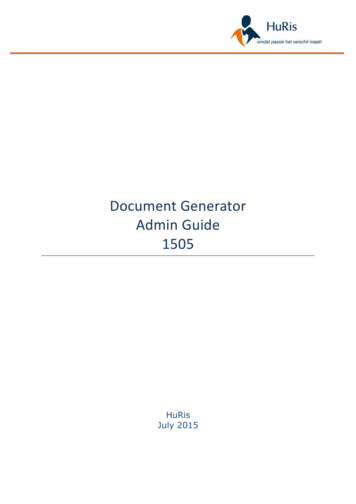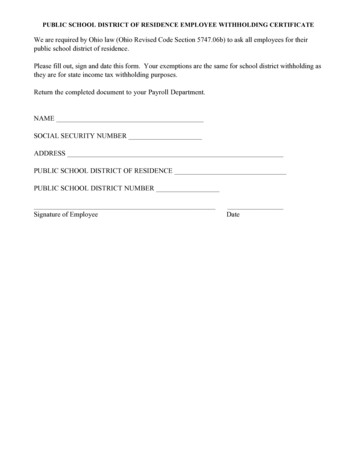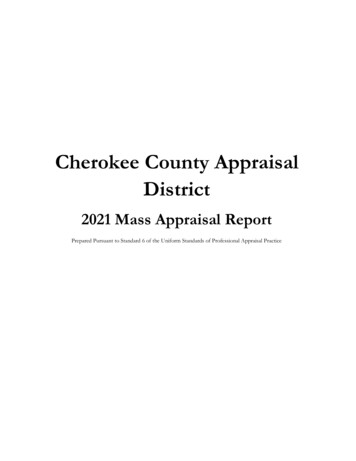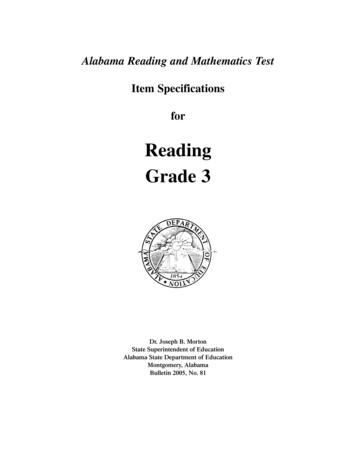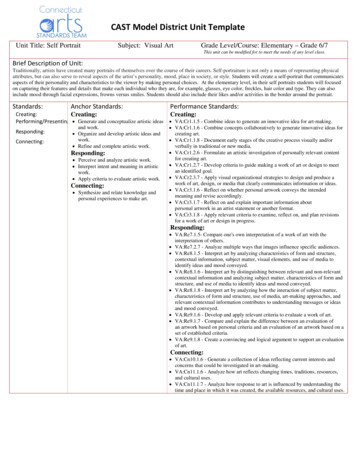
Transcription
CAST Model District Unit TemplateUnit Title: Self PortraitSubject: Visual ArtGrade Level/Course: Elementary – Grade 6/7This unit can be modified for to meet the needs of any level class.Brief Description of Unit:Traditionally, artists have created many portraits of themselves over the course of their careers. Self-portraiture is not only a means of representing physicalattributes, but can also serve to reveal aspects of the artist’s personality, mood, place in society, or style. Students will create a self-portrait that communicatesaspects of their personality and characteristics to the viewer by making personal choices. At the elementary level, in their self portraits students will focusedon capturing their features and details that make each individual who they are, for example, glasses, eye color, freckles, hair color and type. They can alsoinclude mood through facial expressions, frowns versus smiles. Students should also include their likes and/or activities in the border around the portrait.Standards:Anchor Standards:Performance esenting Generate and conceptualize artistic ideas VA:Cr1.1.5 - Combine ideas to generate an innovative idea for art-making.Responding:Connecting:and work. Organize and develop artistic ideas andwork. Refine and complete artistic work.Responding: Perceive and analyze artistic work. Interpret intent and meaning in artisticwork. Apply criteria to evaluate artistic work.Connecting: Synthesize and relate knowledge andpersonal experiences to make art. VA:Cr1.1.6 - Combine concepts collaboratively to generate innovative ideas forcreating art. VA:Cr1.1.8 - Document early stages of the creative process visually and/orverbally in traditional or new media. VA:Cr1.2.6 - Formulate an artistic investigation of personally relevant contentfor creating art. VA:Cr1.2.7 - Develop criteria to guide making a work of art or design to meetan identified goal. VA:Cr2.3.7 - Apply visual organizational strategies to design and produce awork of art, design, or media that clearly communicates information or ideas. VA:Cr3.1.6 - Reflect on whether personal artwork conveys the intendedmeaning and revise accordingly. VA:Cr3.1.7 - Reflect on and explain important information aboutpersonal artwork in an artist statement or another format. VA:Cr3.1.8 - Apply relevant criteria to examine, reflect on, and plan revisionsfor a work of art or design in progress.Responding: VA:Re7.1.5- Compare one's own interpretation of a work of art with theinterpretation of others. VA:Re7.2.7 - Analyze multiple ways that images influence specific audiences. VA:Re8.1.5 - Interpret art by analyzing characteristics of form and structure,contextual information, subject matter, visual elements, and use of media toidentify ideas and mood conveyed. VA:Re8.1.6 - Interpret art by distinguishing between relevant and non-relevantcontextual information and analyzing subject matter, characteristics of form andstructure, and use of media to identify ideas and mood conveyed. VA:Re8.1.8 - Interpret art by analyzing how the interaction of subject matter,characteristics of form and structure, use of media, art-making approaches, andrelevant contextual information contributes to understanding messages or ideasand mood conveyed. VA:Re9.1.6 - Develop and apply relevant criteria to evaluate a work of art. VA:Re9.1.7 - Compare and explain the difference between an evaluation ofan artwork based on personal criteria and an evaluation of an artwork based on aset of established criteria. VA:Re9.1.8 - Create a convincing and logical argument to support an evaluationof art.Connecting: VA:Cn10.1.6 - Generate a collection of ideas reflecting current interests andconcerns that could be investigated in art-making. VA:Cn11.1.6 - Analyze how art reflects changing times, traditions, resources,and cultural uses. VA:Cn11.1.7 - Analyze how response to art is influenced by understanding thetime and place in which it was created, the available resources, and cultural uses.
CAST Model District Unit Template**Enduring Understanding(s):**Essential Questions:Creating:Creating: Artist and designers develop excellence through practice andconstructive critique, reflecting on, revising, and refining work overtime. Creativity and innovative thinking are essential life skills that can bedeveloped.Responding: People gain insights into meanings of artworks by engaging in theprocess of art criticism. People evaluate art based on various criteria.Connecting: Through art-making, people make meaning by investigating anddeveloping awareness of perceptions, knowledge, and experiencesSchool/Lesson Plan EU: An artist can use a self-portrait to not onlyrepresent their likeness but also convey a strong sense of the artist as aperson at the time of the portrait’s creation.Essential Experiences Observation and reflection. Engaging in the creative process. Imaginative thinking through creative problem solving. Making choices/decisions to communicate ideas. Conceive and create original artwork. Analyze, interpret, evaluate, and judge artwork. Refining application of media.Knowledge:Students will know and understand: self-portrait profile view point composition proportion facial features expression likeness personality characteristics feedback observation visual literacy characteristics concept theme What conditions, attitudes, and behaviors support creativity and innovativethinking? How do artists and designers create works of art or design that effectivelycommunicate? How do artists work? How do artists and designers determine whether aparticular direction in their work is effective? How do artists and designers learnfrom trial and error? What role does persistence play in revising, refining, and developing work?How does collaboratively reflecting on a work help us experience it morecompletely?Responding: What is the value of engaging in the process of art criticism? How doesknowing and using visual art vocabularies help us understand and interpretworks of art? How does one determine criteria to evaluate a work of art? How is a personalpreference different from an evaluation?Connecting: How does art help us understand the lives of people of different times, places,and cultures?**IMPORTANT NOTE: Enduring Understandings and Essential Questionsshould be altered to fit the needs and level of your students. How an essentialquestion is written for pre-K students will differ from how it is written for grade 5students.Skills: moodcultureposelightingcreative story aftsmanshipsafety procedurestextlikenessartistic processobservationStudents will: create an original self-portrait make personal choices brainstorm collaboratively think imaginatively/problem solve creatively demonstrate safe use of tools and equipment demonstrate safe use of tools and equipment apply media using proper techniques communicate visually, verbally, and through writing engage in the creative process compare and contrast give and receive feedback combine text and image evaluate tell a story plan practice reflect observe make decisions interpret pay attention to detail make marks document analyze critique evaluate refine
CAST Model District Unit TemplateLearning Objectives:Students will create a self-portrait that represents their likeness and communicates aspects of their personality to the viewer by making personal choices.and will: engage in a class discussion about portraiture as they view exemplars of self portraits from a variety of time periods. recognize and understand how an artist’s likeness, personality, an culture can be shown through their choice of expression, clothing, pose, lightingand other details. understand that an artwork can tell a story. collaboratively brainstorm multiple approaches to creating a self-portrait observe themselves in a mirror and fill in portrait planning sheet with details of how they see themselves (if no mirrors are available studentsshould work in pairs and fill out the sheet for their peer). apply media using proper technique and craftsmanship. understand and demonstrate consistent shading techniques utilizing range of values, light, medium, and dark. reflect on their likes and activities. understand simple facial proportions. practice drawing their portrait to include details such as freckles, glasses, etc. combine text and image make compositional choices decide what they want to include in their portrait the represents them. interpret, and evaluate other’s portraits. provide and receive feedback. observe and discuss visual traits within a selected group of diverse (student created) self-portraits. interpret a peer’s work and create a story based on that interpretation. evaluate their own artwork using the rubric and write an artist statement. evaluate and interpret a peer’s work create a story about that peer’s portrait.Learning Plan/Instructional Strategies:Students will: engage in a class discussion of self-portrait exemplars from a variety of time periods and cultures. Students will collaboratively interpret portrait exemplarsbased on details such as expression, features, pose, clothing, color, mood, lighting, props/objects, etc. be introduced to facial proportions. engage in a class discussion about the background vs. foreground and using text with images in same composition. practice drawing features and portraits using proportion and feature drawing handouts. work in pairs and observe another student, documenting what details they notice about their features. observe themselves in a mirror and document what they see, such as eye color, freckles, etc. fill out planning sheet with their likes, activities, and words that describe their personality. complete homework asking them to interview a family member about their personality, characteristics, traits, etc. draw 3 practice portraits looking in the mirror. share the practice drawings with the teacher and a peer share for feedback looking at preliminary drawings and planning sheet decide what they want to say about themselves in their portrait. create 3 sketches for how the text and/or collage will be incorporated into their self-portrait composition. create a background on a separate piece of paper that includes either words that students would use to describe themselves, and/or collage images of theirlikes and activities. draw their self-portrait showing likeness and value. (light, medium and dark) cut out their drawing and glue it to the background paper overlapping the background image making judgments about placement and composition. evaluate their own artwork using the rubric. trade drawings with a peer and interpret the portrait with a short story about the person in the drawing. share their portrait with the class and explain the story they told about themselves in their drawing and the peer will tell their interpretation of that student’sportrait and through class discussion compare how similar /different the stories are.Resources: Hand outs on facial proportion Student work National Portrait Gallery MoMa Collection National Gallery of Art http://www.an-shinyoung.com/ Jamie PooleRepertoire/Media & Materials Mirrors Planning/practice sheets Sketchbook/sketch paper Drawing Pencils Magazines or computers for collage materials Glue Good Quality Drawing Paper or other quality drawing surface Markers for writing text in the background Scissors Colored pencil (optional)
CAST Model District Unit TemplateAcademic Vocabulary:- portrait- proportion- details- self-portrait- profile- communicate- context- features- interpret- craftsmanship- focal point- crop- collaborate- artist statement- overlapping- background- foreground- frame- tools- compare/contrast- brainstorm- observation- light- dark- expression- similarities/differences- preliminary sketches- text- pose- reflect- critique- full face/frontal- safety procedures- collageDifferentiation/Modification:This lesson can be modified to fit the needs of a variety of students. If students have trouble with looking in the mirror, students can draw from photos. Thedigital photos can be posturized in Photoshop so that the shapes are simplified and/or portraits can be traced using a light box or projector. Instructions can bewritten out and translated in different languages using a translation program. Students can also trace them selves on the mirror using a water-based marker.Trace the marker drawing onto tracing paper and then transfer it onto paper. For students likes and dislikes they can cut things out and collage them in theborder.Extensions: For gifted students they can choose more challenging poses, add props, etc.Here are some more general modifications that can be applied to any lesson: Present instruction/resources verbally and visually. Modify tools and materials. Adjust timelines. Provide various means through which students can communicate their ideas or questions. Encourage students with high ability to modify or interpret outcomes to capture greater levels of complexity or sophistication in interpretations of ideas. Provide varying means through which students can express what they have learned. Encourage students to explore various subtopics of a larger topic or issue. Identify student readiness and learning differences and modify instruction to meet varying needs of students. Have student work in a group with defined jobs, allowing for writing and verbal abilities to share thoughts/opinions.Assessments: Must link to unit standards and objectives. What evidence will be used to demonstrate studentshave met the standards and achieved the learning objectives?Summative Assessment** (use Attached template)Formative Assessment Description:Assessments may include but are not limited to: critique (verbal, written) conversation with students rubrics self assessments artist statementsHere are some general assessment strategies that can be used for any lesson. Students should receive instruction that builds on previous knowledge and skills prior to beginning the assessment. Knowledge and skills in this assessment should be taught in the classroom. Students should have adequate opportunity and time to learn what is expected of them. Expectations for learning should be clearly stated for students prior to beginning the assessments. Students should have many opportunities to demonstrate what they have learned and to work through difficulties they may experience. Assessment should represent what has been taught or should have been taught.Notes:If you would like to add Presenting to this lesson, you can have the students create their own exhibit either on a bulletin board or a showcase. They can decidehow the portraits should be displayed. This would bring in the Presenting Anchor Standard: Select, analyze and interpret artistic work for presentation, andPerformance Standard: VA:Pr5.1.6 - Individually or collaboratively, develop a visual plan for displaying works of art, analyzing exhibit space, the needs ofthe viewer, and the layout of the exhibit and VA:Pr5.1.7 - Based on criteria, analyze and evaluate methods for preparing and presenting art.
NameSelf-Portrait Assessment - Grade 6Final Student Artwork: RubricAdvancedAccurately observedproportions ANDfeatures resemblethose of the student.Accuracy ofProportionsand likenessFeatures are placed inproportion to eachother.Included all observeddetails such asdimples, frecklesscars, hair type, eyeshape, etc. accurately.CreatingRendering ofFigureIncluded a full rangeof shading and valuefrom dark to light.Created smoothtransition betweenvalues. Observed realshadows on the faceand included them inthe drawing.Uses values to makeAll areas of figurelook 3-dimensionalGoalProficientTried to observe theindividual shapes andmostly accurateproportions ANDfeatures show someresemblance to thestudentNeed assistance to onhow to observe facialfeatures. Mostlyaccurate proportionsOR features showsome resemblance tothe student.All included facialfeatures are in relativeproportion to eachother.At least half of thefacial features aredrawn in proportionto where they shouldbe.Included mostobserved details suchas dimples, frecklesscars, hair type, eyeshape, etc. accurately.Attempted to create afull range of shadingand value from darkto light. Had slightchoppy transitionbetween values. Didnot observe detailssuch as real shadowsand highlights.Uses values to makeMost areas of figurelook 3-dimensionalIncluded a fewobserved details suchas dimples, frecklesscars, hair type, eyeshape, etc. accurately.Only a few varyingtones are evident. Didnot observe detailssuch as actualshadows. Little or notransition betweenvalues.Uses values to makeSome areas of figurelook 3-dimensionalEmergingRequired assistanceto observe facialfeatures. Someaccurate proportions.Features somewhatresemble actualfeatures or drew thefeatures withoutobserving them.BasicNo or very fewaccurate proportions.Features do notresemble those of thestudent or do norrepresent actualfeatures. No self portrait was drawn.No facial features aredistinguishable toFacial features are not determine proportionsdrawn proportionally. or features are placeout proportion.Included one or twoobserved details such Included no observeddetails such asas dimples, frecklesscars, hair type, eyedimples, frecklesshape, etc. accurately. scars, hair type, eyeshape, etc. accurately.Portrait demonstratesminimal shading. Notransition betweenshades. Observed nodetails such asshadows on the face.Figure appears flatPortrait demonstratesno to almost noshadingFigure appears flat
AdvancedMediaApplicationPlanning ngCraftsmanship isCraftsmanship ismostly consistent.Craftsmanship isexcellent.inconsistent.Craftsmanship is Most areas are All areas aremostly lacking. Some areas arecarefully andcarefully andconsistentlycarefully rendered; Rendering isconsistentlyrenderedother are notattempted, butrendered For the most part, Some strokes follow generally sloppy Strokes followstrokes follow thethe direction of the Strokes aredirection of thedirection of theshapes; some do not haphazardly applied,shapes, enhancingshapes, enhancingso shapes appear flat Presentation of thethe formsthe formswork is inconsistent, Presentation is Great care is shown Good care is shownwith some carelessgenerally carelessin the presentationin the presentationareasof the workof the workCompletedCompleted someCompleted almost allCompleted fewpreliminary drawingspreliminary drawingspreliminary drawingspreliminary drawingsincluding studies ofincluding studies ofincluding studies ofincluding studies ofeyes, nose, mouth andeyes, nose, mouth andeyes, nose, mouth andeyes, nose, mouth andears.ears.ears.ears.Completed 3 fullpractice sketchesCritique –Creating/Refining andResponding RevisingArtworkIdentifiescharacteristics ofquality for an artworkin progress; providesrationale and appliesthese criteria whenexamining andreflecting on thework, and makesrevisions accordinglyCompleted 3 fullpractice sketchesIdentifiescharacteristics ofquality for an artworkin progress;effectively appliesthese criteria whenexamining andreflecting on thework, and makesrevisions accordingly.Completed 2 fullpractice sketchesIdentifiescharacteristics ofquality for an artworkin progress; does noteffectively applythese criteria whenexamining andreflecting on the workand does not makerevisions accordingly.Completed 1 or nofull practice sketchesIdentifies some orfew characteristics ofquality for an artworkin progress; does noteffectively applythese criteria whenexamining andreflecting on the workand does not makerevisions accordingly.BasicCraftsmanship islacking. Rendering isattempted, butgenerally sloppy Strokes arehaphazardly applied,so shapes appear flat Presentation isgenerally carelessCompleted no or veryfew preliminarydrawings includingstudies of eyes, nose,mouth and ears.Completed no fullpractice sketchesDoes not identifycharacteristics ofquality for an artworkin progress; does notapply criteria whenexamining andreflecting on the workand if revisions aremade they are notbased on criteria.
AdvancedConstructs a highlyplausible and creativeinterpretation of anartwork by analyzingParticipationin depth how subjectin Classmatter, visualResponding Discussion andelements, formalinterpretationcomposition, media,of others’ workand relevantcontextualinformation interactto convey meaning.DocumentDocuments keyprocess ofstages in the processdevelopingof developing aideas fromcomplex theme orConnectingearly stages toidea from early stagesfullyto the entEmergingBasicConstructs aninterpretation of anartwork by analyzinghow subject matter,visual elements,formal composition,media, and relevantcontextualinformation interactto convey meaning.Constructs a limitedinterpretation of anartwork with analysisof how subjectmatter, visualelements, formalcomposition, media,and relevantcontextualinformation interactto convey meaning.Constructs a limitedinterpretation of anartwork with limitedanalysis of howsubject matter, visualelements, formalcomposition, media,and relevantcontextualinformation interactto convey meaning.Constructs a limitedor no interpretation ofan artwork with noanalysis of howsubject matter, visualelements, formalcomposition, media,and relevantcontextualinformation interactto convey meaning.Documents process ofdeveloping a theme oridea from early stagesto the completedwork.Partially documentsprocess of developinga theme or idea fromearly stages to thecompleted work.Does not documentprocess of developinga theme or idea fromearly stages to thecompleted work.
engage in a class discussion of self-portrait exemplars from a variety of time periods and cultures. Students will collaboratively interpret portrait exemplars based on details such as expression, features, pose, clothing, color, mood, lighting, p




